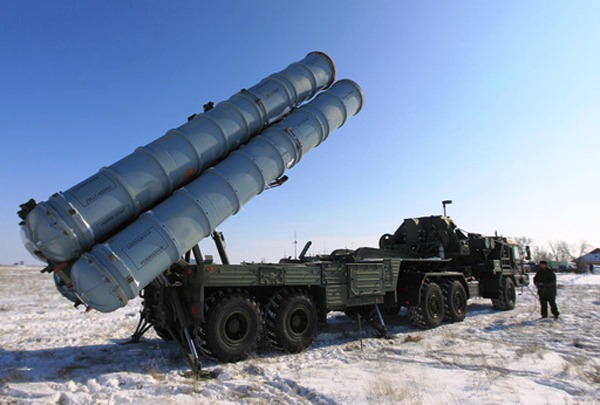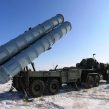
Russia’s “New Look” Military Reaches out to Space
Publication: Eurasia Daily Monitor Volume: 9 Issue: 140
By:

Russia’s Armed Forces, facing continued and long term convulsions due to inadequately planned and poorly executed defense reform, has further complicated the process by developing and introducing the Aerospace Defense Forces (Vozdushno Kosmicheskaya Oborona – VKO), which faces multiple technical and organizational challenges. On August 10-16, the VKO will conduct its first military exercise using the new S-400 (Triumph) air defense missile system at the Ashuluk training range in Astrakhan Oblast; the system is designed to destroy modern and emerging reconnaissance aircraft, and strategic and tactical air assets (Vzglyad, July 18).
The first S-400 live fire exercises involving the new structure will include two battalions from an S-400 regiment in Dmitrov, near Moscow, under the leadership of the VKO Deputy Commander Lieutenant-General Sergei Lobov. The military exercise will explore organizational issues and the level of combat training, ahead of S-400 regimental equipment being introduced in the inventory by the end of 2012. The Russian military currently possesses four S-400 regiments – two stationed near Moscow, one in the Baltic Fleet and the fourth in the Russian Far East. The air defense system is designed to destroy long and intermediate range air and missile targets, and can target reconnaissance aircraft; strategic and tactical attack platforms; tactical, operational-tactical and intermediate-range ballistic missiles; hypersonic targets; jamming aircraft; AWACS planes; etc. The S-400 missiles system can fire up to 72 missiles at 36 separate targets (Vzglyad, RIA Novosti, July 18).
An intensification of air defense exercises is also evident in Russia’s Far East, with an air defense drill commencing on July 18 for two months in Khabarovsk, involving more than 1,000 personnel and conducted using 14 training grounds within the Far East Military District (MD). A spokesman for the Far East MD stated that the exercise is being conducted taking into account the experience of modern warfare, specifically “NATO’s air operations in Afghanistan, Iraq and Libya” (Interfax, July 18).
However, these exercises and the continued publicity surrounding the new Russian VKO provide an often misleading image of the capabilities of Russia’s Armed Forces. Since the formation of the Aerospace Defense Forces, a series of articles by Russian air defense specialists have questioned key features of the VKO and stressed its experimental and high-technology nature – concluding in the process that the VKO faces many challenges and still has not arrived in its final organizational form. These conclusions fit with the constant tinkering and ad hoc policy-making that has attended Russian defense reform since Defense Minister Anatoliy Serdyukov was tasked with overseeing the introduction of the “New Look” in October 2008 (see EDM, November 1, 2011; March 27).
The latest illustration of the complexities facing Russian defense planners, midstream in the modernization of the Armed Forces, was provided by an insightful article by Major-General Aleksandr Tsymbalov, arguing that the key mission of the VKO is to ensure strategic mobility. Tsymbalov’s article is important because in it he not only considers the underlying theory and concepts linked to the VKO, but applies critical judgment on how it will fit into the wider “New Look,” arguing that more change is needed to refine and perfect the capability of the Aerospace Defense Forces (Vozdushno-Kosmicheskaya Oborona, https://www.vko.ru/DesktopModules/Articles/ArticlesView.aspx?tabID=320&ItemID=501&mid=2869&wversion=Staging, July 2012).
Tsymbalov had a number of critical observations both about the “New Look” and the VKO in particular. These ranged from discussing how the means and methods of modern conflict have fundamentally shifted, noting the network-centric level of modern military capabilities as well as the need to redefine doctrine and tactics to fit these changes. He also suggests that Moscow is in a military evolutionary process of moving toward developing such capabilities in space, marking a transition in the methods and sphere in which military conflict will be conducted in the future. However, despite the talk by the top brass about introducing new tactics to fit network-centric approaches to conflict, Tsymbalov said that nothing has yet fundamentally changed: “Meanwhile, the problem of developing new operational and tactical forms and methods of employing the Russian Armed Forces in present-day (not to mention future) military conflicts is far from resolved for various reasons, and provisions for these forms and methods of troop actions contained in new regulation documents (2010-2011) differ little from provisions of the Voyennyy Entsiklopedicheskiy Slovar (Military Encyclopedic Dictionary) (1986)” (Vozdushno-Kosmicheskaya Oborona, https://www.vko.ru/DesktopModules/Articles/ArticlesView.aspx?tabID=320&ItemID=501&mid=2869&wversion=Staging, July 2012).
Tsymbalov argues that in the period 2020-2025, offensive aerospace operations and campaigns will replace offensive air operations and campaigns: “New offensive aerospace weapons will appear: strike spacecraft [udarnyye kosmicheskiye apparaty], aerospace planes [giperzvukovyye samolety], hypersonic cruise missiles [giperzvukovyye krylatyye rakety], hypersonic aircraft [giperzvukovyye samolety], and a new generation of maneuvering [manevriruyushchiy] ballistic missile warheads, which will lead to airspace and outer space being turned into a common sphere of warfare.” Tsymbalov is in no doubt that the creation of the VKO marks recognition by Moscow that outer space and airspace will be the main spheres of future military operations (Vozdushno-Kosmicheskaya Oborona, https://www.vko.ru/DesktopModules/Articles/ArticlesView.aspx?tabID=320&ItemID=501&mid=2869&wversion=Staging, July 2012).
In order to ensure its strategic mobility, the Russian military will need to focus on asymmetric actions and the use of pre-emptive strikes using long range aircraft and precision-guided munitions, which is supported by the 2010 Military Doctrine for defensive purposes. Tsymbalov concludes that the VKO missions will only be possible after creating a fully unified reconnaissance and air attack warning system, and argues the VKO must avoid focusing upon enemy strike complexes, and instead target “reconnaissance, EW [electronic warfare], command and control, and data processing and distribution system facilities” (Vozdushno-Kosmicheskaya Oborona, https://www.vko.ru/DesktopModules/Articles/ArticlesView.aspx?tabID=320&ItemID=501&mid=2869&wversion=Staging, July 2012).
The ongoing experiments within the “New Look,” searching for meaning in and systematic approaches to the transition, while adopting fresh approaches to modern combat operations – combined with the challenges involved in the VKO – reveal a picture of Moscow struggling to cope with such complexities. The tactics and methods may remain largely unchanged in the combat training manuals, but the creation and further development of the VKO signifies two crucial features in Russian defense planning: the future of warfare is becoming more high-tech and will increasingly operate in the sphere of outer space, and its optimization will demand new approaches to military science as well as continued investment in research and development to support such advances.




